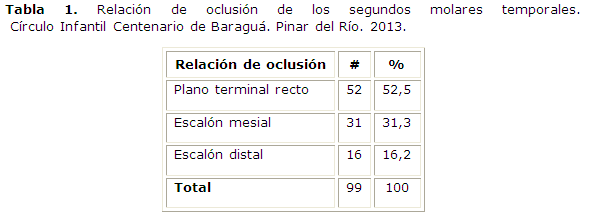Risk factors associated with malocclusions in temporal teeth
Keywords:
Dental occlusion, Malocclusion, Diastema, Risk factors.Abstract
Introduction:malocclusion is established as a result of the interaction between genetic and environmental factors, these limitations are given by individual variations in every subject where the features of temporal dentition must be considered. There are attributes such as: terminal planes, kind of dental arch, vulnerability of caries for temporal dentition, presence of harmful oral habits, and the absence of inter-incisor diastemas are risk factors triggering malocclusions.Objective: to characterize the risk factors triggering malocclusion in temporal teeth.
Material and Method: an observational, descriptive and cross-sectional research was carried out in children from 3 to 5 years old at Centenario de Baragua Day Care Center in Pinar del Río during January-March 2013, a clinical-oral examination was performed, data of interest were collected using them as summary measures for the absolute frequencies and percentages.
Results: terminal plane rectum was the most frequent, open bite predominated as dentomaxillofacial anomaly, upper primate space prevailed, and protractile tongue was the most common oral habit.
Conclusion: the greatest responsibilities fall on in these risk factors for the onset of malocclusions in temporal dentition, leading to the future development of malocclusions in permanent teeth, thus to eliminate or restrict its influence is a task for all.
Downloads
References
1. Mayoral J, Mayoral G. Ortodoncia: Principios fundamentales y práctica. 7 ed. Barcelona: Labor, 1995: 96-105.
2. Bhayya DP, Shyagali TR, Dixit UB. Study of occlusal characteristics of primary dentition and the prevalence of maloclusion in 4 to 6 years old children in India. Dent Res J (Isfahan). 2012 Sep; 9(5):619-23. Available from: http://www.ncbi.nlm.nih.gov/pmc/articles/PMC3612201/
3. Esteller Moré E, Pons Calabuig N, Romero Vilariño E, Puigdollers Pérez A, Segarra Isern F, Matiñó Soler E, et al. Alteraciones del desarrollo dentofacial en los trastornos respiratorios del sueño infantil. Acta Otorrinolaringol Esp [internet]. 2011 [citado marzo 2012]; 62(2):132-9. Disponible en: http://zl.elsevier.es/es/revista/acta-otorrinolaringologica-espanola-102/alteraciones-desarrollo-dentofacial-los-trastornos-respiratorios-sueno-90001381-originales-2011?bd=1
4. Lambrechts H, De Baets E, Fieuws S, Willems G. Lip and tongue pressure in orthodontic patients. Eur J Orthod [internet]. 2010 [citado dic 2012]; 32(4):466-71. Disponible en:http://ejo.oxfordjournals.org/content/32/4/466.full
5. Castelo PM, Gavião MB, Pereira LJ, Bonjardim LR. Maximal bite force, facial morphology and sucking habits in young children with functional posterior crossbite. J Appl Oral Sci [internet]. 2010 [citado marzo 2012]; 18(2):143-8. Disponible en: http://www.scielo.br/scielo.php?script=sci_arttext&nrm=iso&lng=es&tlng=es&pid=S1678-77572010000200008
6. Ghafournia M, Hajenourozali Tehrani M. Relationship between bruxism and malocclusion among preschool children in Isfahan. J Dent Res Dent Clin Dent Prospects. 2012; 6(4):138-42. Available from: http://www.ncbi.nlm.nih.gov/pmc/articles/PMC3529927/
7. Pipa Vallejo A, Cuerpo García de los Reyes P, López-Arranz Monje E, González García M, Pipa Muñiz I et al. Prevalencia de maloclusión en relación con hábitos de succión no nutritivos en niños de 3 a 9 años en Ferrol. Av Odontoestomatol [internet]. 2011 [citado dic 2012]; 27 (3): 137-45. Disponible en: http://scielo.isciii.es/scielo.php?script=sci_arttext&pid=S0213-12852011000300004&lng=es&nrm=iso
8. León Caballero KM, Maya Hernández B, Vega Galindo M, Mora Pérez Clotilde. Factores de riesgo asociados con anomalías de oclusión en dentición temporal: Área III. Rev Cubana Estomatol [revista en la Internet]. 2007 Dic [citado 2014 Mar 05]; 44(4): Disponible en http://scielo.sld.cu/scielo.php?script=sci_arttext&pid=S0034-75072007000400003&lng=es
9. García VJ, Ustrell Torrent JM, Sentís Vilalta J. Evaluación de la maloclusión, alteraciones funcionales y hábitos orales en una población escolar: Tarragona y Barcelona. Av Odontoestomatol. 2011; 27 (2): 75-84.
10. Medrano Luna JE, Cedillo Galindo SL, Murrieta Prunela JF. Prevalencia de factores de riesgo para el desarrollo de la oclusión/ Rev ADM 2002; 59(4): 128-133.
11. González Valdés D, González Fernández M, Marín Manso G. Prevalencia de diastemas en la dentición temporal. Rev cubana ortod 1999; 14(1): 22-6.
12. Retamoso LB, Knop LA, Guariza Filho O, Tanaka OM. Facial and dental alterations according to the breathing pattern. J Appl Oral Sci. 2011; 19(2): 175-81.
13. Dos Santos RR, Nayme JG, Garbin AJ, Saliba N, Garbin CA, Moimaz AS Prevalence of Malocclusion and Related Oral Habits in 5-to 6-year-old Children. Oral Health Prev Dent. 2012; 10(4):311-8.
14. Podadera-Valdés Z, Flores-Podadera L, Rezk-Díaz A. Repercusión de la respiración bucal en el sistema estomatognático en niños de 9 a 12 años. Revista de Ciencias Médicas de Pinar del Río [revista en Internet]. 2013 [citado 2014 Mar 5]; 17(4): [aprox. 11 p.]. Disponible en: http://www.revcmpinar.sld.cu/index.php/publicaciones/article/view/1317
15. Rodríguez LR. Ortodoncia caso clínico: mordida cruzada anterior y posterior. DigitalCef Cefalometría digital 2011 [revista en Internet]. Disponible en: http://digitalcef.com.ar/blog/acerca-del-software/ortodoncia-caso-clinico-mordida-cruzada-anterior-y-posterior/
16. Proffit WR. The etiology of the orthodontic problems. In: Proffit WR, Fields HW, eds. Contemporary Orthodontic. 3ed. St. Louis: Mosby, 2000: 13-144.
17. Colectivo de autores.Odontología pediátrica. Caracas: Ed Disinlimed; 2010.

Published
How to Cite
Issue
Section
License
Authors who have publications with this journal agree to the following terms: Authors will retain their copyrights and grant the journal the right of first publication of their work, which will be publication of their work, which will be simultaneously subject to the Creative Commons Attribution License (CC-BY-NC 4.0) that allows third parties to share the work as long as its author and first publication in this journal are indicated.
Authors may adopt other non-exclusive license agreements for distribution of the published version of the work (e.g.: deposit it in an institutional telematic archive or publish it in a volume). Likewise, and according to the recommendations of the Medical Sciences Editorial (ECIMED), authors must declare in each article their contribution according to the CRediT taxonomy (contributor roles). This taxonomy includes 14 roles, which can be used to represent the tasks typically performed by contributors in scientific academic production. It should be consulted in monograph) whenever initial publication in this journal is indicated. Authors are allowed and encouraged to disseminate their work through the Internet (e.g., in institutional telematic archives or on their web page) before and during the submission process, which may produce interesting exchanges and increase citations of the published work. (See The effect of open access). https://casrai.org/credit/


